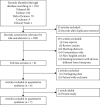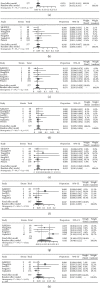Intracranial Angioplasty with Enterprise Stent for Intracranial Atherosclerotic Stenosis: A Single-Center Experience and a Systematic Review
- PMID: 33959660
- PMCID: PMC8075681
- DOI: 10.1155/2021/6645500
Intracranial Angioplasty with Enterprise Stent for Intracranial Atherosclerotic Stenosis: A Single-Center Experience and a Systematic Review
Abstract
Background: The high rate of periprocedural complications for the endovascular stent procedure in the Stenting Versus Aggressive Medical Management Therapy for Intracranial Arterial Stenosis (SAMMPRIS) trial resulted in it being less recommended than medical therapy to treat intracranial atherosclerotic stenosis (ICAS). Because Enterprise stent use might reduce the incidence of complications in ICAS treatment compared to other frequently used stents, this paper evaluated the safety and effectiveness of the Enterprise stent for the treatment of ICAS.
Methods: We performed a comprehensive literature search for reports on intracranial angioplasty using the Enterprise stent for ICAS treatment from the earliest date available from each database to May 2020 for PubMed, EMBASE, Web of Science, Cochrane, and Clinical Trials databases. We also reviewed the single-center experience of the First Affiliated Hospital of Harbin Medical University. We extracted information regarding periprocedural complications, procedure-related morbidity, mortality, immediate angiographic outcome, and long-term clinical and angiographic outcomes, among others. Event rates were pooled across studies using random-effects or fixed-effects models depending on the heterogeneity.
Results: Five hundred fifty-seven patients with 588 lesions from seven studies, including the institutional series, were included in the analysis. The incidence of stroke or death within 30 days was 7.4% (95% confidence interval (CI), 5.5%-10.1%). The incidence of ischemic stroke or TIA in the territory of the qualifying artery beyond 30 days and during follow-up was 3.2% (95% CI, 1.1%-9.5%). The incidence of in-stent restenosis was 10.1% (95% CI, 4.6%-22.2%), and the incidence of symptomatic restenosis was 4.1% (95% CI, 1.7%-9.9%).
Conclusions: Intracranial angioplasty utilizing the Enterprise stent for ICAS treatment was relatively safe and effective but required further verification using additional sources for evidence.
Copyright © 2021 Bowen Sun et al.
Conflict of interest statement
The authors declare that there is no conflict of interest regarding the publication of this paper.
Figures


Similar articles
-
Medium-term results of undersized angioplasty and stenting for symptomatic high-grade intracranial atherosclerotic stenosis with Enterprise.Interv Neuroradiol. 2019 Oct;25(5):484-490. doi: 10.1177/1591019919832244. Epub 2019 Apr 16. Interv Neuroradiol. 2019. PMID: 30991867 Free PMC article.
-
Factors affecting in-stent restenosis after angioplasty with the Enterprise stent for intracranial atherosclerotic diseases.Sci Rep. 2021 May 18;11(1):10479. doi: 10.1038/s41598-021-89670-x. Sci Rep. 2021. PMID: 34006896 Free PMC article.
-
Enterprise stent for the treatment of symptomatic intracranial atherosclerotic stenosis: an initial experience of 44 patients.BMC Neurol. 2015 Oct 8;15:187. doi: 10.1186/s12883-015-0443-9. BMC Neurol. 2015. PMID: 26449986 Free PMC article.
-
Percutaneous Transluminal Angioplasty with Stent Placement versus Best Medical Therapy Alone in Symptomatic Intracranial Arterial Stenosis: A Best Evidence Review.Cureus. 2018 Jul 16;10(7):e2988. doi: 10.7759/cureus.2988. Cureus. 2018. PMID: 30397562 Free PMC article. Review.
-
Balloon-mounting stent versus balloon angioplasty for intracranial arterial stenosis: A systematic review and meta-analysis.J Stroke Cerebrovasc Dis. 2024 May;33(5):107631. doi: 10.1016/j.jstrokecerebrovasdis.2024.107631. Epub 2024 Feb 6. J Stroke Cerebrovasc Dis. 2024. PMID: 38331010
Cited by
-
Drug-Coated Balloons for the Treatment of Symptomatic Intracranial High-Grade Stenosis: A Review of the Current Rationale.Front Neurol. 2021 Jul 27;12:692208. doi: 10.3389/fneur.2021.692208. eCollection 2021. Front Neurol. 2021. PMID: 34385971 Free PMC article. Review.
-
Hemodynamic and Geometric Risk Factors for In-Stent Restenosis in Patients with Intracranial Atherosclerotic Stenosis.Oxid Med Cell Longev. 2022 Jul 27;2022:6951302. doi: 10.1155/2022/6951302. eCollection 2022. Oxid Med Cell Longev. 2022. Retraction in: Oxid Med Cell Longev. 2024 Jan 9;2024:9863972. doi: 10.1155/2024/9863972. PMID: 35936215 Free PMC article. Retracted.
-
Short-term outcome of stenting with Enterprise stents for symptomatic intracranial atherosclerotic disease at a single center.Interv Neuroradiol. 2023 Dec;29(6):731-737. doi: 10.1177/15910199221133166. Epub 2022 Oct 19. Interv Neuroradiol. 2023. PMID: 36259331 Free PMC article.
-
Intracranial angioplasty with a self-expandable stent for intracranial atherosclerotic stenosis: Systematic review and meta-analysis.Front Neurol. 2023 Jan 9;13:1074228. doi: 10.3389/fneur.2022.1074228. eCollection 2022. Front Neurol. 2023. PMID: 36698897 Free PMC article.
-
Optional or optimal? off-label stenting for intracranial atherosclerotic stenosis: A scoping review.Interv Neuroradiol. 2025 Aug;31(4):555-566. doi: 10.1177/15910199231171811. Epub 2023 Apr 26. Interv Neuroradiol. 2025. PMID: 37122266 Free PMC article.
References
-
- Krishnamurthi R. V., Feigin V. L., Forouzanfar M. H., et al. Global and regional burden of first-ever ischaemic and haemorrhagic stroke during 1990-2010: findings from the Global Burden of Disease Study 2010. The Lancet Global Health. 2013;1(5):e259–e281. doi: 10.1016/S2214-109X(13)70089-5. - DOI - PMC - PubMed
Publication types
MeSH terms
LinkOut - more resources
Full Text Sources
Other Literature Sources
Medical

